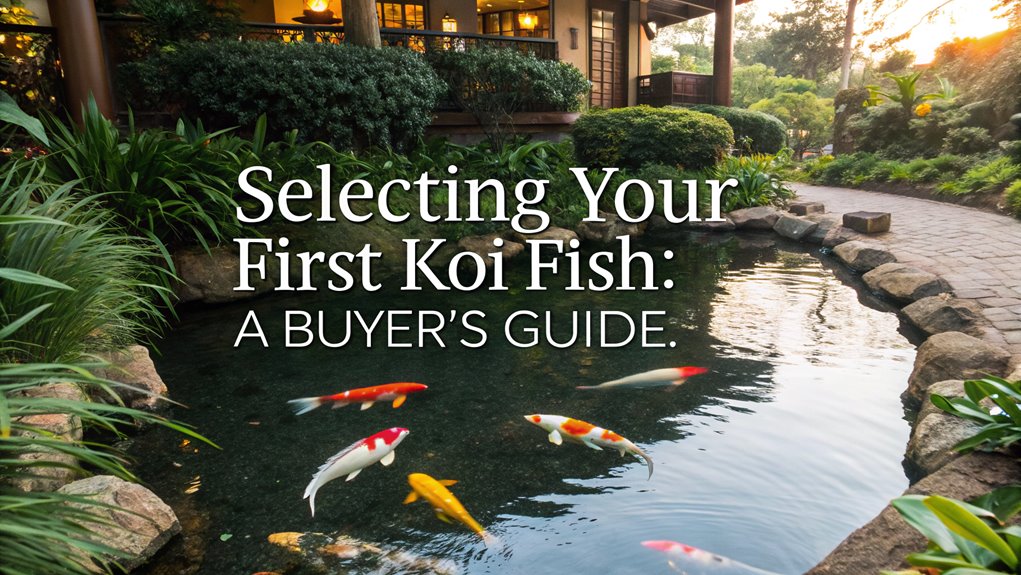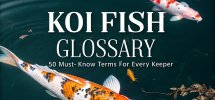When selecting your first koi fish, focus on koi varieties like Kohaku for its white and red patterns. Find reputable dealers known for healthy koi with thorough information. The pond should exceed 1,000 gallons with a depth of 3 feet, maintaining 0 ppm ammonia and nitrites. Choose koi that swim actively with clear eyes and undamaged scales. Quarantine is essential to prevent diseases. By further exploring, you’ll guarantee your koi thrive in their new environment.
TLDR
- Choose a reputable koi dealer with healthy, well-monitored stock and knowledgeable staff.
- Select a pond size of at least 1,000 gallons, with a depth of 3 feet.
- Look for active koi with clear eyes and bright, undamaged scales.
- Quarantine new koi for two weeks to prevent disease transmission.
- Ensure pond water parameters match the needs of your selected koi.
Understanding Different Types of Koi Fish
When you’re beginning to explore the world of koi fish, understanding the different types is crucial for making an informed selection.
Japanese koi come in over 100 varieties, but the Gosanke trio—Kohaku, Sanke, and Showa—are the most revered.
Kohaku boasts a metallic white body with vivid red patterns, a classic since 1888.
Sanke, with its pure white base embellished with red and black markings, symbolizes balance.
Showa stands out with a black body adorned with red and white, offering a unique contrast.
Other popular varieties include the graceful Butterfly Koi and the solid-colored Ogon.
When selecting koi, prioritize fish that are healthy to guarantee their long-term health and well-being in your pond environment.
Choosing a Reputable Koi Dealer
How do you guarantee your first koi purchase is a success? Start by selecting koi dealers with a strong reputation for offering healthy koi. A reputable dealer should provide high-quality fish and a variety of koi species, each with detailed information about their characteristics and care needs.
Ascertain the dealer’s staff is knowledgeable about koi health and fish health, ready to answer any queries. Verify they conduct regular health monitoring, including tests for the Koi Herpes Virus, and maintain stringent water quality standards.
Look for evidence of quarantine procedures for new arrivals to prevent disease spread. Finally, seek recommendations and reviews from fellow koi enthusiasts to assess the dealer’s commitment to maintaining exceptional fish health and welfare.
Determining the Right Pond Size and Environment
Establishing the ideal pond size and environment is fundamental for your koi’s health and growth. When buying koi, verify you have a pond size of at least 1,000 gallons, providing 500 gallons per koi fish. This space supports their potential growth to 36 inches.
A depth of at least 3 feet is essential for shelter and stable water temperatures.
In koi keeping, maintaining ideal water conditions is vital. Regularly test to keep ammonia and nitrites at 0 ppm and nitrates below 40 ppm, with pH levels between 6.8 and 8.4.
Install efficient filtration and oxygenation systems to maintain healthy varieties and oxygen levels, especially in warm months, preventing the spread of harmful substances in your tank or pond.
Selecting Healthy and Active Koi Fish
With your pond’s size and conditions set to support koi, the next step is ensuring the fish you select are healthy and active.
Begin by observing the koi’s behavior—choose ones that enthusiastically swim and respond to feeding. These are signs of an active and healthy fish.
Here’s a checklist to guide you:
- Overall Behavior: Active swimmers that don’t isolate themselves.
- Clear Eyes and Gills: No cloudiness or discoloration, which might indicate signs of illness.
- Bright Scales: Shiny, undamaged scales suggest good health.
- Group Inspection: If multiple koi seem unhealthy, reconsider buying from that source.
Ensure that the selected koi will thrive in your pond’s water parameters.
These steps will help you select fish that are both robust and vibrant.
Importance of Quarantine Procedures
Quarantining new koi is essential to maintaining a healthy pond ecosystem. Implementing quarantine procedures in a separate tank is vital to prevent disease transmission to your existing pond fish.
During this two-week period, closely observe koi to monitor for signs of health issues, such as lethargy, damaged fins, or unusual behavior. Quarantine not only helps the koi recover from transportation stress but also allows them to adapt to the new water conditions before entering the main pond environment.
It’s important that your new arrivals are healthy and free from parasites, ensuring the well-being of your entire aquatic community. Always purchase from responsible dealers who adhere to strict quarantine protocols, guaranteeing koi that are ready for a seamless changeover.
Feeding and Caring for Your New Koi Fish
After confirming your new koi are healthy and ready for the pond, focus on proper feeding and care to support their growth and well-being.
Koi require a balanced diet, starting with high-quality koi pellets as their primary food source. Supplement their diet with treats like lettuce and shrimp to enhance nutrition. Regular feeding, at least twice a day, is vital, but avoid overfeeding as it can harm water quality.
To maintain peak water quality, regularly monitor:
- Ammonia, Nitrite, Nitrate, pH: Essential for a stable environment.
- Water Temperature: Adjust feeding frequency and type based on seasonal changes.
- Regular Water Changes: Key to managing nitrate levels.
- Care for Your Koi: Guarantees a healthy, thriving habitat.
This beginners guide guarantees vibrant, healthy koi.
Frequently Asked Questions
What Is the Best Koi Fish for Beginners?
When selecting your first koi, prioritize Kohaku for its striking red and white contrast. Also consider Taisho Sanshoku for balanced aesthetics. Butterfly Koi offer hardy resilience. Make certain they’ve bright scales and maintain a 1,000-gallon pond minimum.
What to Look for When Buying Koi Fish?
When buying koi, choose vibrant fish that dance at feeding, indicating vigor. Guarantee their eyes and gills are clear, scales gleam, and they’re lesion-free. Confirm the seller’s quarantine period and check your pond’s capacity.
What Is the Beginner Guide for Koi Fish?
You should start by researching koi varieties, focusing on beginner-friendly options like Kohaku or Sanke. Guarantee your pond is at least 1,000 gallons. Always quarantine new koi and choose healthy, active fish with bright scales.
What Is the Most Sought After Koi Fish?
You’ll find Kohaku, Sanke, and Showa are the “Big 3” in koi collecting. Kohaku’s classic red-on-white patterns, Sanke’s harmonious colors, and Showa’s striking tricolor patterns make them highly desirable due to their exceptional beauty.
Conclusion
As you venture into the world of koi keeping, it’s no coincidence that your attention to detail will pay off. By selecting vibrant, healthy koi from a reputable dealer, ensuring your pond is the ideal environment, and enforcing strict quarantine procedures, you’ll create a thriving aquatic habitat. Feed your koi a balanced diet and monitor their health meticulously. Your dedication transforms this hobby into a rewarding experience, where each koi gracefully glides through the water, showcasing your expert care.


